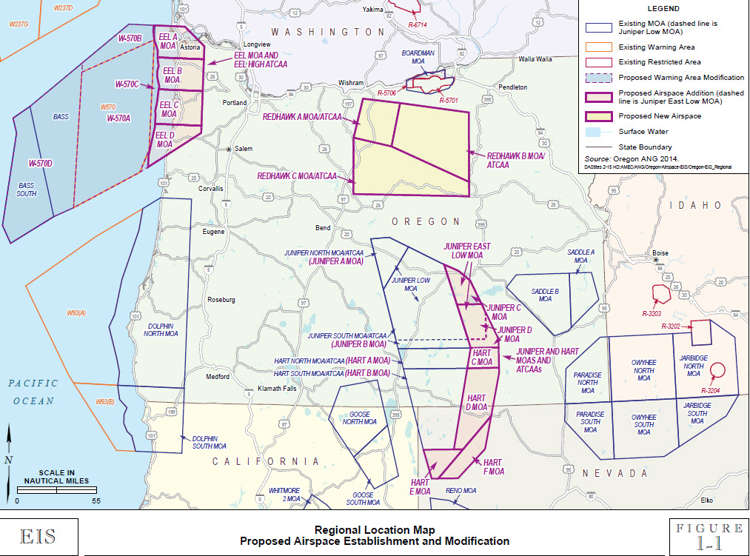Oregon Air National Guard - Military Operation Agreement, MOA Contact
June 28, 2017
Agreement between Pacific Soaring Council, Inc., "PASCO"
and Oregon Air National Guard "OANG" 6-28-2017
A major benefit of having a central organization like Pacific Soaring Council, Inc (PASCO) representing a large group of glider operations is that other organization have a single organization to contact that has a method to contact all the other clubs and businesses.
Military Operations Areas (MOAs) for this agreement:
- Goose MOA - 3K AGL to FL 280
- Hart MOA - 11K to FL510
- Juniper MOA - 300 ft to FL 510
- Dolphin MOA - 11K to FL 510
- Varmit MOA - FL 200 to FL 230

Click on Map to see all 4 detailed pages in a larger view
Flying in these areas - WHAT YOU CAN DO:
View the Agreement between PASCO and OANG and other Documents
- Agreement - OANG-Memorandum-Of-Understanding-06-28-2017.pdf
- Klamath Falls Flight Safety - OANG-MACA-flyer-CY2017(2)-06-28-2017.pdf
- Regional Location Map - OANG-AFD-140206-103-06-28-2017.pdf
- Kingsley Field Airspace Updates - OANG-AFD-130520-018-06-28-2017.pdf
Overview
In June 2017 PASCO was contacted by Major Duffy from the Klamath Falls, Oregon Air National Guard. Major Duffy was looking for Soaring Community contacts regarding changes to MOAs that they were planning.
Major Kurt "Ripple" Duffy from Kingsley Field, Klamath Falls, Oregon Air National Guard, was collecting information from soaring clubs around them to make sure that the MOA Airspace Initiative is understood by all.
The Major was having trouble contacting the various Soaring Clubs and sites to get the information he needed, so he contacted Pacific Soaring (PASCO).
Jim Wallis , PASCO President, contacted and received input from each of our four northern-most California and Nevada soaring operations,
- Montague Soaring Area
- Air Sailing
- Soar Truckee
- Williams Soaring Center
as well as the Willamette Valley Club and provided the following feedback:
It does appear that we have relatively little glider traffic from our area into or near the Juniper/Hart areas. The response from Montague indicated that they simply don't go in that direction and didn't have any expectation of doing so. Flights originating from Williams typically track along the Cascade Range so little conflict is seen from there,either. Flights out of Truckee have made it into the Juniper/Hart area, but this seems to be very rare. The respondent indicated he had only been there once in 30 years.
Part of this stems from the lack of facilities. Although the Willamette club flies in or near Juniper/Hart during the Summer, pilots making long distance flights from our area are conscious about sparse airports and population as well as difficult radio and telephone communication so tend to be cautious about routes into or through that area.
Members of the Air Sailing operation (Nevada) have made "several" flights over the past five years of distances that could put them into the Juniper/Hart area. Their feeling is that when these flights do occur, they take place mostly on weekends (our understanding is that most of your training operations take place during the work week) thus there should be a natural avoidance of potential traffic conflicts on that basis.
Generally, then, soaring pilots in our area seem to feel that the expanded MOA's will not represent a significant problem to glider flight operations or safety. All respondents were particularly enthusiastic about the prospect of receiving information from 173 FW regarding anticipated operations schedules, and I think dissemination of that information would be very well received.
